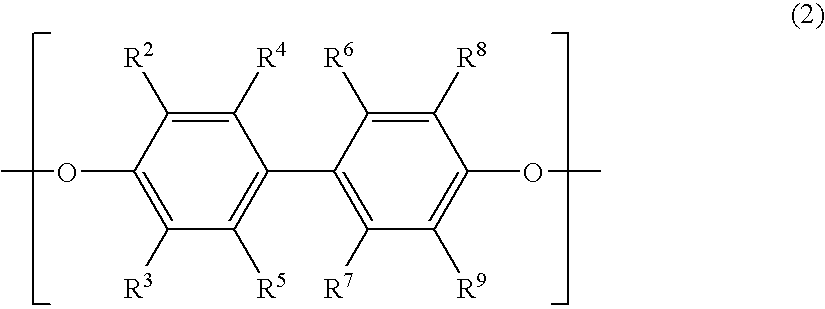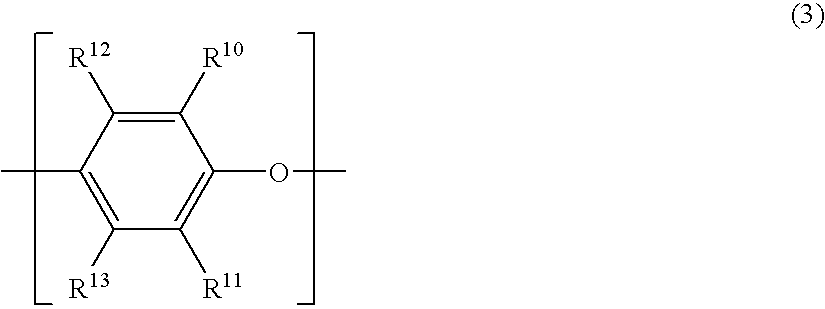Polyphenylene ether oligomer sulfonic acid salt, making method, flame retardant resin composition, and molded article
a technology of polyphenylene ether and oligomer sulfonic acid, which is applied in the directions of drug delivery mechanism, dragees, etc., can solve the problems of decomposition of phosphorus based flame retardants, detracting from the mechanical strength of resin compositions, and environmental pollution, so as to improve mechanical strength, weld strength, impact strength, and the effect of improving the mechanical strength
- Summary
- Abstract
- Description
- Claims
- Application Information
AI Technical Summary
Benefits of technology
Problems solved by technology
Method used
Image
Examples
synthesis example 1
Synthesis of Difunctional OPE (A)
[0087] A 20-L volume elongated reactor equipped with a stirrer, thermometer, air inlet tube and baffles was charged with 13 g of copper (I) chloride, 795 g of di-n-butylamine and 6,000 g of toluene. The contents were stirred at a reaction temperature of 40° C. With stirring, a mixed solution of 418 g of 2,2′,3,3′,5,5′-hexamethyl-(1,1′-biphenyl)-4,4′-diol and 915 g of 2,6-dimethylphenol in 6,000 g of methanol (molar ratio of dihydric phenol to monohydric phenol was 1:5) was added dropwise to the reactor over 150 minutes while bubbling air at 2 L / min. An aqueous solution of disodium dihydrogen ethylenediaminetetraacetate was added to the reaction solution to terminate the reaction. Thereafter, the reaction solution was washed with 1N hydrochloric acid and then deionized water. The solution was concentrated on an evaporator, obtaining 2,560 g of a 50 wt% toluene solution of difunctional OPE (A). The difunctional OPE (A) thus obtained was analyzed by GP...
synthesis example 2
Synthesis of OPE-2Gly (A)
[0088] A 5-L volume reactor equipped with a stirrer, thermometer and dropping funnel was heated at 100°C. and charged with 800 g of the 50 wt% toluene solution of difunctional OPE (A) obtained above and 2,100 g of epichlorohydrin. Thereafter, 201 g of a 23 wt% ethanol solution of sodium ethoxide was added dropwise over one hour from the dropping funnel. The dropwise addition was followed by 5 hours of stirring. The reaction mixture was washed with deionized water, after which the organic layer was separated. The toluene and excess epichlorohydrin were distilled off from the solution. The remainder was vacuum dried, leaving 430 g of OPE-2Gly (A). The OPE-2Gly (A) thus obtained was analyzed by GPC, finding a number average molecular weight of 1,040 and a weight average molecular weight of 1,650. It had an epoxy equivalent of 515 g / mol.
example 1
Synthesis of Sodium Salt of Sulfonic Acid of Polyphenylene Ether Oligomer (A)
[0089] A 1-L volume flask equipped with a stirrer, cooling condenser, thermometer and dropping funnel was charged with 206 g of the OPE-2Gly (A) obtained above and 481 g of methyl isobutyl ketone. By stirring for one hour at room temperature, the oligomer was dissolved to form a uniform solution. The flask was heated to an internal temperature of 80-90° C., after which an aqueous solution containing 43.7 g of sodium hydrogen sulfite, 2.5 g of sodium sulfite and 115.5 g of deionized water was added dropwise over one hour. The reaction mixture was stirred for 5 hours under reflux.
[0090] The reaction mixture was heated in an oil bath at 130° C. to distill off the water and methyl isobutyl ketone substantially. It was cooled to room temperature, after which 400 g of methyl isobutyl ketone was added again. The mixture was stirred for one hour at room temperature to form a uniform dispersion, which was filtered...
PUM
| Property | Measurement | Unit |
|---|---|---|
| temperature | aaaaa | aaaaa |
| glass transition temperature | aaaaa | aaaaa |
| temperature | aaaaa | aaaaa |
Abstract
Description
Claims
Application Information
 Login to View More
Login to View More - R&D
- Intellectual Property
- Life Sciences
- Materials
- Tech Scout
- Unparalleled Data Quality
- Higher Quality Content
- 60% Fewer Hallucinations
Browse by: Latest US Patents, China's latest patents, Technical Efficacy Thesaurus, Application Domain, Technology Topic, Popular Technical Reports.
© 2025 PatSnap. All rights reserved.Legal|Privacy policy|Modern Slavery Act Transparency Statement|Sitemap|About US| Contact US: help@patsnap.com



